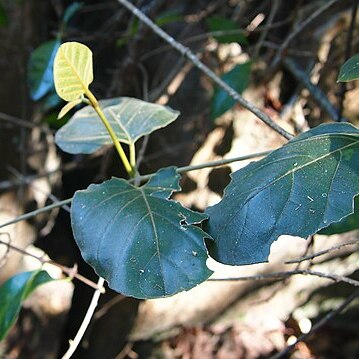Vine to 8 m high or more; branchlets pubescent, brown; new growth velvety; latex clear. Juvenile leaves sinuately lobed, cordate. Adult leaves soft; petiole 10–41 mm long, pubescent; lamina ovate or oblong-ovate, 3–19 cm long, 2–9 cm wide, cordate at base, acuminate to a fine point apically, softly pubescent to scabrous on upper surface, softly densely pubescent on lower surface with fawn or brown hairs, sometimes glabrescent; secondary veins 4–7 pairs, prominent, raised below, net veins distinct below; domatia absent. Inflorescence of axillary, many-flowered panicles; flowers in 2–6 dense clusters per panicle; axes pubescent; peduncles 0.2–13 cm long, often bifurcating or trifurcating at apex; pedicels 0.5–2.5 mm long. Calyx lobes c. 2 mm long, pubescent. Corolla cream or brown, pubescent externally; tube cylindrical, 1.3 mm long; lobes erect, ovate, 2–2.5 mm long, bearded internally at base. Anther cone c. 2 mm long, not exserted; filaments straight, 0.4 mm long; anther tails divergent. Nectary scales discrete, thick, with 2 or 4 apical lobes. Capsules fusiform, slender, 7–16 cm long, 0.4–1.4 cm diam., shortly pubescent to velvety, sometimes glabrescent.

